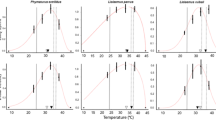Summary
-
1.
Oxygen consumption (\(\dot V_{O_2 } \)), carbon dioxide production (\(\dot V_{CO_2 } \)), and stamina were measured in the lizardTupinambis nigropunctatus running at sustainable and non-sustainable velocities (v) on a motor-driven treadmill. Three experimental groups were measured: field-fresh animals at body temperature (T b)=35°C and laboratorymaintained animals atT b=35 and 25 °C.
-
2.
Mean preferredT b was determined to be 35.2 °C.
-
3.
At 35 °C, field-fresh animals had a greater maximal oxygen consumption (\(\dot V_{O_{2 } max corr} \)) (4.22 vs 3.60 ml O2 g−0.76 h−1) and a greater endurance. The net cost of transport (slope of\(\dot V_{O_2 } v^{ - 1} \) onv) did not differ between the groups (=2.60 ml O2 g−0.76 km−1). Velocity at which\(\dot V_{O_{2\max } } \) is attained (MAS) is 0.84 km h−1. The respiratory exchange ratio (R) exceeded 1.0 atv above MAS, indicating supplementary anaerobic metabolism.
-
4.
At 25 °C,\(\dot V_{O_{2 } max corr} \) was lower (2.34 ml O2 g−0.76 h−1) as was endurance, MAS occurring at 0.5 km h−1. Net cost of transport was not significantly different than at 35 °C.
-
5.
The effect ofT b on locomotory costs was analyzed for this lizard and other species. It was concluded that the net cost of transport is temperature independent in all species examined and the total cost of locomotion\(\dot V_{O_2 } v^{ - 1} \) is temperature dependent inTupinambis (Q10=1.4–2.0) and all other species examined except one. The energetic cost of locomotion [(\(\dot V_{O_2 active} - \dot V_{O_2 rest} \))v −1], previously reported to be temperature independent in lizards, is temperature dependent inTupinambis (Q10=1.3–1.6) and in two other species.
-
6.
Previous work has interpreted the energetic cost of locomotion as reflecting thermally independent costs of muscle force generation in vivo. These conclusions are questioned on both their generality and their practical and theoretical bases.
Similar content being viewed by others
Abbreviations
- MAS :
-
maximal aerobic speed
- R :
-
respiratory exchange ratio
References
Bakker RT (1972) Locomotor energetics of lizards and mammals compared. Physiologist 15:76
Bennett AF (1972) The effect of activity on oxygen consumption, oxygen debt, and heart rate in the lizardsVaranus gouldii andSauromalus hispidus. J Comp Physiol 79:259–280
Bennett AF (1978) Activity metabolism of the lower vertebrates. Annu Rev Physiol 40:447–469
Bennett AF (1982) The energetics of reptilian activity. In: Gans C, Pough FH (eds) Biology of the reptilia, vol 13: Academic Press, New York, pp 155–199
Bennett AF, Dawson WR (1976) Metabolism. In: Gans C, Pough FH (eds) Biology of the reptilia, vol 5. Academic Press, New York, pp 127–223
Bennett AF, Gleeson TT (1979) Metabolic expenditure and the cost of foraging in the lizardCnemidophorus murinus. Copeia 1979:573–577
Brett JR (1964) The respiratory metabolism and swimming performance of young sockeye salmon. J Fish Res Bd Canada 21:1183–1226
Dmi'el R, Rappeport D (1976) Effect of temperature on metabolism during running in the lizardUromastix aegyptius. Physiol Zool 49:77–84
Fry FEJ (1947) Effects of the environment on animal activity. Pub Ont Fish Res Lab 68:1–62
Glass ML, Johansen K, Abe AS (1981) Pulmonary diffusing capacity in reptiles: Relations to temperature and oxygen uptake. J Comp Physiol 142:509–514
Gleeson TT (1979a) Foraging and transport costs in the Galapagos marine iguana,Amblyrhynchus cristatus. Physiol Zool 52:549–557
Gleeson TT (1979b) The effects of training and captivity on the metabolic capacity of the lizardSceloporus occidentalis. J Comp Physiol 129:123–128
Gleeson TT (1981) Preferred body temperature, aerobic scope, and activity capacity in the monitor lizard,Varanus salvator. Physiol Zool 54:423–429
Gleeson TT, Bennett AF (1982) Acid-base imbalance in lizards during activity and recovery. J Exp Biol 98:439–453
Gleeson TT, Mitchell GS, Bennett AF (1980) Cardiovascular responses to graded activity in the lizardsVaranus andIguana. Am J Physiol (Reg Integ Comp Physiol) 8:R174-R179
John-Alder HB (1984) Seasonal variation in activity, aerobic energetic capacities, and plasma thyroid hormones (T3 and T4) in an iguanid lizard. J Comp Physiol B 154:409–420
John-Alder HB, Bennett AF (1981) Thermal dependence of endurance and locomotory energetics in a lizard. Am J Physiol 241 (Reg Integ Comp Physiol 10): R342-R349
John-Alder HB, Lowe CH, Bennett AF (1983) Thermal dependence of locomotory energetics and aerobic capacity of the gila monster (Heloderma suspectum) J Comp Physiol 151:119–126
Kleinbaum DG, Kupper LL (1978) Applied Regression Analysis and Other Multivariable Methods. Duxbury Press, North Scituate, Massachusetts
Klemm RD, Gatz RN, Westfall JA, Fedde MR (1979) Microanatomy of the lung paranchyma of a tegu lizardTupinambis nigropunctatus. J Morphol 161:257–280
Mertens R (1942) Die Familie der Warane (Varanidae). I. Allgemeines. Abh Senckenberg Naturforsch Ges 462:1–116
Moberly WR (1968) The metabolic responses of the common iguana,Iguana iguana, to walking and diving. Comp Biochem Physiol 27:21–32
Perry, SF, Duncker HR (1978) Lung architecture, volume, and static mechanics in 5 species of lizards. Respir Physiol 34:61–82
Rome LC (1982) Energetic cost of running with different muscle temperatures in savannah monitor lizards. J Exp Biol 99:269–277
Rome LC, Kuchmerick MJ (1983) Energetics of isometric contractions as a function of muscle temperature. Am J Physiol 244 (Cell Physiol 13):C100-C109
Schmidt-Nielsen K (1972) Locomotion: Energy cost of swimming, flying, and running. Science 177:222–228
Taylor CR, Schmidt-Nielsen K, Raab JL (1970) Scating of energetic cost of running to body size in mammals. Am J Physiol 219:1104–1107
Tucker VA (1970) Energetic cost of locomotion in animals. Comp Biochem Physiol 34:841–846
Author information
Authors and Affiliations
Rights and permissions
About this article
Cite this article
Bennett, A.F., John-Alder, H.B. The effect of body temperature on the locomotory energetics of lizards. J Comp Physiol B 155, 21–27 (1984). https://doi.org/10.1007/BF00688787
Accepted:
Issue Date:
DOI: https://doi.org/10.1007/BF00688787




